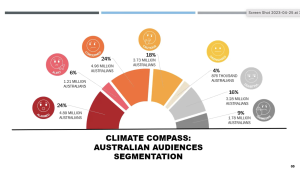 Dr Rebecca Huntley, one of Australia’s leading researchers on climate communication, provides a roadmap for talking about the climate crisis in ways that will inspire and equip enough people to make a difference. She gave a fabulous overview as the keynoter for ESRAG’s 2023 Annual Meeting, and you can watch and share it from the ESRAG website. Click on this “climate” link and scroll down to find the recording.
Dr Rebecca Huntley, one of Australia’s leading researchers on climate communication, provides a roadmap for talking about the climate crisis in ways that will inspire and equip enough people to make a difference. She gave a fabulous overview as the keynoter for ESRAG’s 2023 Annual Meeting, and you can watch and share it from the ESRAG website. Click on this “climate” link and scroll down to find the recording.
You don’t have to be a climate scientist to earn people’s attention: if people with PhDs were the right voices to get the world to change, “we’d already be there,” she said. But because of your community relationships “you are already powerful.” Think of the networks you are part of – in Rotary, at work, your friends and shared pastimes. The affection and esteem in which they hold you gives real influence. Understand your audience – their values and experiences – and appeal to those as you share your climate concerns.
Dr Huntley urges us to speak about “objects of concern: what and whom you want to protect,” such as the children in your town unable to play safely outside because of air pollution from wildfires. “We tend to show both the impacts of and solutions to climate change without people in the picture,” she said. “If you live in the Philippines, you won’t see a lot of polar bears. I am not in love with solar panels or wind farms, but I am in love with what they can do for people.”
She recommends that you draw on the research of the Yale Program for Climate Change Communication and George Mason University, who have analyzed the segments of climate opinion in about 150 countries around the world, testing campaigns and compiling evidence on messaging that is effective in each segment except climate deniers or dismissives – a small minority. “Everyone else is reachable – if not on the science, then definitely on the solutions,” she says.

Yale Program for Climate Change Communication and George Mason chart of Australian climate opinion audience segments, shared by Dr Huntley in her talk
Another comprehensive, free resource she recommends to guide your messaging is Climate Outreach with its reports and guides on climate communication, and its libraries of videos, blogs, and images. The Climate Visuals programme “is the world’s only evidence-based and impact focused climate photography resource.” The images have captions, credits, and are either free through Creative Commons or available for licensing.
ESRAG Chair Pat Armstrong asked Dr Huntley for her top tips. Here they are:
- Try to localize the issue: how is climate change directly affecting the community of the person you’re talking to? Local media can be compelling in showing local effects of climate change.
- Share stories of how local people are addressing the climate crisis in ways that bring co-benefits, like better health or saving money.
- Find a balance between warning about the risks of inaction and the benefits of action. We need to show that there has been harm and loss and there will be more, without overwhelming people.
- Understand what facts and values are salient to your audience, and focus on those. Don’t bombard them.
Whether you use podcasts, TV, or short videos on social media, “what counts,” Dr Huntley summed up, “ is the quality of the storytelling: how you connect with people’s values and elicit their emotions.”